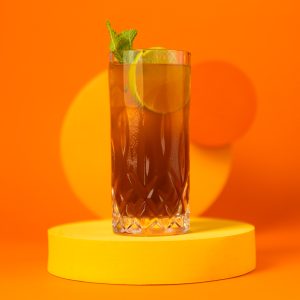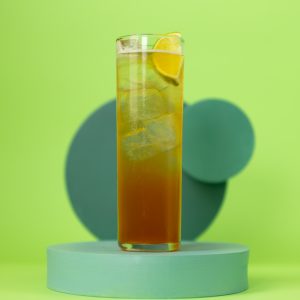Try this easy Opera Cocktail recipe! With Gin, Dubonnet, Maraschino liqueur and orange bitters, it's the perfect cocktail for a cool fall night or for a post opera nightcap.
Prep time: 1 minute minute
Mixing time: 1 minute minute
Servings: 1
Calories: 163
Ingredients
- 1½ oz Gin
- ⅔ oz Dubonnet Rouge
- ⅓ oz Maraschino Liqueur
- 2 dashes Orange Bitters
- Ice cubes
- Orange zest twist - for garnish, optional
Equipment
- Cocktail Glass
- Measuring Jigger
- Mixing Glass
- Bar spoon or long stirrer
- Cocktail Strainer
Instructions
- Prep Glass: Fill your coupe glass with ice. Set it aside.
- Add Bitters: Pour 2 dashes Orange Bitters into the mixing glass.
- Add Maraschino: Measure and pour ⅓ oz Maraschino Liqueur into the mixing glass.
- Add Dubonnet: Add ⅔ oz Dubonnet Rouge into the mixing glass.
- Add Gin: Finally, add 1½ oz Gin to the mix.
- Add Ice and Stir: Fill the mixing glass with ice. Using a bar spoon or a long stirrer, stir well (for about 15-20 seconds). Give it a taste and stir a bit more if you feel like more dilution is necessary.
- Strain: Take your coupe glass and discard the ice inside. Using the cocktail strainer, strain the mixture into the chilled glass.
- Garnish: Garnish with an orange twist: to do so, express the orange zest on top of the drink and then place it on the rim of the glass or drop it directly inside.
Notes
Substitutes:
- Gin: If you don't have Gin, vodka can be used as a substitute, although it will give a less botanical flavor. You can try using pisco for a different yet interesting twist.
- Dubonnet Rouge: This is a sweet, aromatized wine-based aperitif. You can use sweet vermouth or Lillet Rouge if you can't find it.
- Maraschino Liqueur: This is a cherry-flavored liqueur. If you don't have it on hand, you can substitute cherry syrup or cherry brandy, although the taste will be quite different as the maraschino has a very specific, signature taste. An older version of the drink, published by J. Straub in 1914, also mentions using mandarin liqueur (such as Mandarine Napoléon) to make this drink. That can also be a great alternative, either if you choose to completely replace the maraschino with mandarin liqueur or to make a blend of both.
- Orange Bitters: If you don’t have orange bitters, you can use lemon bitters as a substitute or simply leave them out altogether.
Making a Pitcher of The Opera Cocktail:
- Scale: To make a pitcher that serves 8, multiply all the ingredients by 8. That would be 12 oz of Gin, 5 oz of Dubonnet Rouge, 2 ½ oz of Maraschino Liqueur and 16 dashes of orange bitters.
- Mix: In a large pitcher, combine the orange bitters, Gin, Dubonnet Rouge, and Maraschino Liqueur. Add ice and stir well. Give it a taste and stir a bit more if you feel like more dilution is necessary and strain to remove the ice.
- Serve: Pour the mixture into individual chilled cocktail glasses (Martini or coupe style), garnish with an orange twist, and serve immediately. Be sure to put the pitcher back into the fridge or freezer between each serving in order for your drink to remain as cold as possible.
Making it Non-Alcoholic:
- Gin Substitute: Use a non-alcoholic gin substitute; these are available and reasonably mimic Gin's botanicals.
- Dubonnet Rouge Substitute: Opt for a non-alcoholic red wine or red/sweet vermouth.
- Maraschino Liqueur Substitute: Use a cherry-flavored syrup instead of the liqueur.
- Proceed As Usual: Use these non-alcoholic substitutes instead of the regular ingredients, follow the original steps, and enjoy a non-alcoholic version.
Making it Vegan:
The Opera Cocktail is naturally vegan as it contains no animal products. However, always check your ingredients' labels to ensure they are vegan. Some brands may use animal products in their production process, especially when filtration and coloring are involved.What is a The Opera Cocktail?
An Opera Cocktail is a gin-based classic cocktail made of Gin, Dubonnet Rouge, Maraschino liqueur, and Orange Bitters. This drink is relatively easy to make as it only requires measuring ingredients accurately and mixing them effectively. The Opera Cocktail is considered a variant of the Martinez, with the addition of Dubonnet Rouge giving it a unique twist.

What is The Opera Cocktail made of – The ingredients
The Opera Cocktail is made with the following ingredients:
- Gin: It forms the cocktail’s base, providing a strong, juniper-forward flavor.
- Dubonnet Rouge: A sweet, aromatized wine that adds depth and complexity to the cocktail.
- Maraschino Liqueur: This cherry-flavored liqueur imparts a subtle sweetness and fruitiness.
- Orange Bitters: These add a citrusy note and balance out the sweetness of the other ingredients.
- Orange Twist: Used as a garnish to add a fresh citrus aroma and a visually appealing touch, enhancing both the flavor and presentation of the cocktail.




















